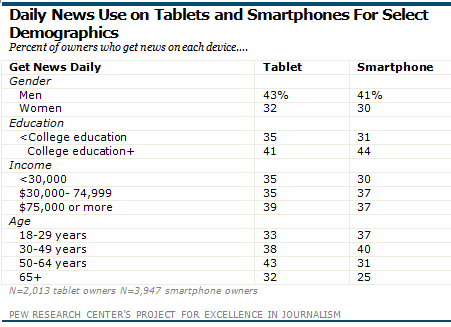The internet and digital devices are changing our news consumption habits. Here are 12 trends to put the rapidly shifting digital news landscape into perspective:
1. More Americans get news online… 50% of the public now cites the internet as a main source for national and international news, still below television, but far above newspapers and radio. (Report)

2. …Especially younger Americans: 71% of those 18-29 cite the internet as a main news source, more than the percentage that cites television (55%). Among those 30-49, 63% say the internet is where they go to get most of their news, matching the percentage who say television is their top news source for the first time. Older Americans have been slower to embrace the internet as a main news source. (Report)

3. Social media has grown as a source for news: 19% of Americans saw news on a social network “yesterday” in 2012, more than double the 9% who had done so in 2010. Those in their 30s (30%) are nearly as likely as those 18-24 (34%) to say they saw news or news headlines on Facebook or another social networking site yesterday. (Report)
4. More American adults consume news on mobile: 64% of tablet owners and 62% of smartphone owners said they got news on their devices in 2012. 73% of tablet owners read in-depth articles at least sometimes, including 19% who did so daily. 61% of smartphone news consumers at least sometimes read longer stories, 11% regularly. (Report)
5. The majority of mobile news users get most of their news through the browser: In 2012, 60% of tablet news users and 61% of smartphone news users get news mostly from their device’s browser. Less than half as many, 23% of tablet news users and 28% of smartphone news users, mainly use apps. And 16% and 11%, respectively, say they use apps and the browser equally. (Report)

6. Tablet users are more engaged: In 2012, 31% of tablet news users said that they spent more time with news since getting their device. Another 43% said that the device was adding to the amount of news they consume. (Report) And 73% of tablet users said they read in-depth articles on their tablet. (Report)
7. Online news consumers see more press bias, less integrity: 65% of those who consider the internet a main news source say news organizations are politically biased, while 73% say news organizations spend too much time on unimportant stories and 81% say news organizations are often influenced by powerful people. (Report)
8. More Americans turn to the internet for campaign news: In the 2012 presidential election, 47% of Americans used the internet as a main campaign news source, surpassing newspapers (27%), radio (20%) and magazines (3%), but still trailing television (67%). (Report)

9. More news consumers ‘dual-screen’ live events: 27% of Americans who watched the November 2012 election night returns “dual-screened” the event, using the internet and television at the same time to follow the live coverage. (Report)
10. During an emergency, Twitter became an information lifeline: 34% of the Twitter discourse about Hurricane Sandy was news and information, including news organizations providing content, government sources offering information and people sharing their own eyewitness accounts and passing along information to others. (Report)
11. Young people get less news, except on mobile: While they are much lighter news consumers generally and have largely abandoned the print news product, young people get news on mobile devices to similar degrees as older users according to 2012 data. On tablets, daily news consumption rates are similar across all four age groups studied. On the smartphone, owners under 50 get news at higher rates than those over 50. (Report)
12. ‘Grazing’ the news has become more popular with younger adults and online readers: In 2012, 57% of Americans said they get news when they want, while 37% get news at regular times. Younger news consumers and those who get news online or from social networks are more likely to say they check in on the news from time to time. (Report)











